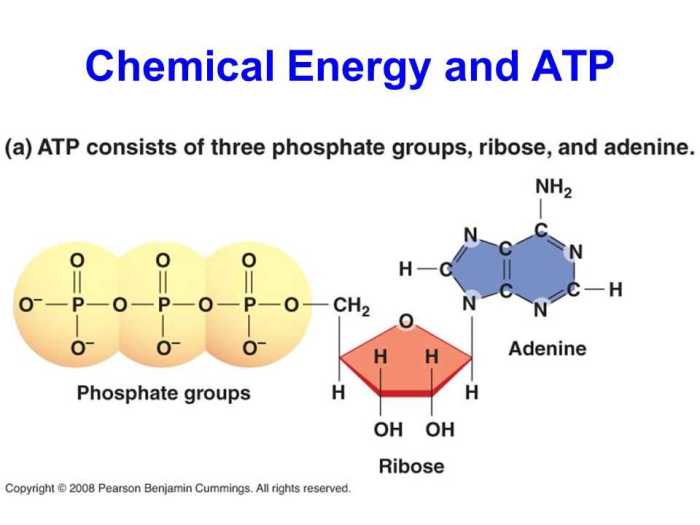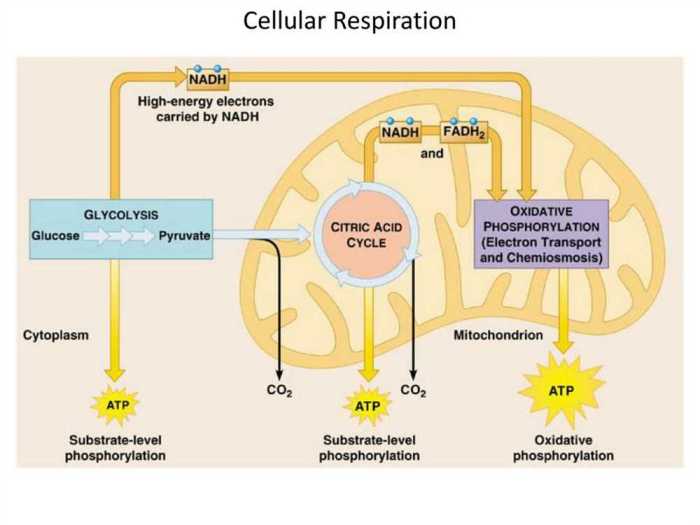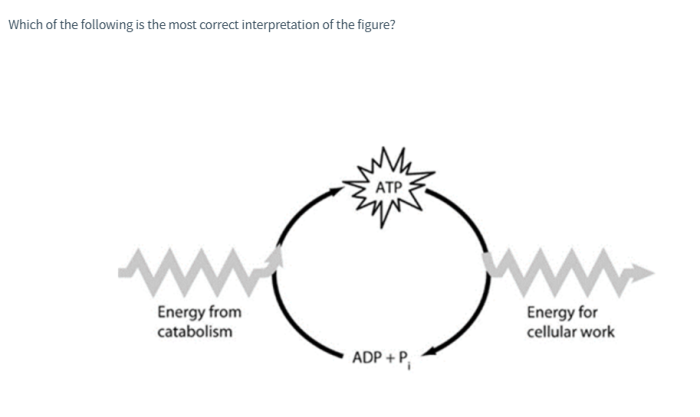Delving into the realm of cellular energetics, this exploration centers on ATP, the pivotal energy carrier of cells. ATP Free Energy Carrier Pogil Answers serves as a comprehensive guide, unraveling the intricate mechanisms underlying ATP’s role in fueling cellular processes.
Prepare to embark on an enlightening journey into the world of ATP and its indispensable contribution to life’s symphony.
ATP, a molecule of remarkable simplicity yet profound significance, stands as the universal energy currency of cells. Its structure, composed of an adenine base, a ribose sugar, and three phosphate groups, belies the extraordinary power it wields within the cellular realm.
ATP: The Energy Carrier
ATP (adenosine triphosphate) serves as the primary energy currency of cells, facilitating energy transfer for various cellular processes. It acts as a universal energy carrier, ensuring the availability of energy where and when required.
Structure and Composition
ATP consists of three components: adenine, ribose, and a triphosphate group. Adenine is a nitrogenous base, while ribose is a five-carbon sugar. The triphosphate group, comprising three phosphate groups linked together, carries the energy.
Free Energy and ATP

Free energy is the energy available to do work in a system. It is often referred to as the Gibbs free energy, after the American scientist Josiah Willard Gibbs who first described it. Free energy is a measure of the spontaneity of a reaction.
A reaction with a negative free energy change is spontaneous, meaning that it will occur without the input of external energy. A reaction with a positive free energy change is non-spontaneous, meaning that it will not occur without the input of external energy.
ATP hydrolysis is the breakdown of ATP into ADP and inorganic phosphate (Pi). This reaction releases free energy that can be used to drive other cellular processes. The free energy released by ATP hydrolysis is about 7.3 kcal/mol. This energy can be used to drive a variety of cellular processes, including muscle contraction, protein synthesis, and nerve impulse transmission.
Role of ATP in Cellular Processes
- ATP is the primary energy currency of the cell. It is used to power all of the cell’s activities, from muscle contraction to protein synthesis.
- ATP is a small molecule that is easily transported throughout the cell. This makes it an ideal energy carrier.
- ATP is constantly being recycled. As ATP is used to power cellular processes, it is converted to ADP. ADP is then converted back to ATP by the cell’s mitochondria.
ATP Synthesis

ATP synthesis, the process of creating adenosine triphosphate (ATP), is central to energy metabolism in cells. Oxidative phosphorylation, a key mechanism for ATP synthesis, occurs in the mitochondria of eukaryotic cells and involves the electron transport chain and ATP synthase.
Electron Transport Chain
The electron transport chain is a series of protein complexes embedded in the inner mitochondrial membrane. Electrons from NADH and FADH2, generated during glycolysis and the citric acid cycle, are transferred through the chain, releasing energy. This energy is used to pump protons across the membrane, creating an electrochemical gradient.
ATP Synthase
ATP synthase is a large protein complex that spans the inner mitochondrial membrane. Protons flowing down the electrochemical gradient drive the rotation of a rotor within ATP synthase. This rotation causes a conformational change in the enzyme, leading to the synthesis of ATP from ADP and inorganic phosphate.
ATP Utilization

ATP is the primary energy currency of cells, powering a wide range of cellular processes essential for life.
ATP is utilized in various cellular functions, including:
Muscle Contraction
- ATP provides energy for myosin heads to slide along actin filaments, causing muscle contraction.
Active Transport
- ATP is used to pump molecules and ions against their concentration gradients across cell membranes.
Protein Synthesis
- ATP provides energy for ribosomes to assemble amino acids into proteins.
Cell Division
- ATP is required for spindle fibers to separate chromosomes during cell division.
Nerve Impulse Transmission, Atp free energy carrier pogil answers
- ATP is utilized by sodium-potassium pumps to maintain the electrochemical gradient across neuronal membranes.
Biosynthesis Reactions
- ATP provides energy for endergonic reactions involved in the synthesis of biomolecules.
Regulation of ATP Levels

Cells have evolved intricate mechanisms to maintain optimal ATP levels, ensuring a continuous energy supply for cellular processes. These regulatory mechanisms involve feedback loops and allosteric enzymes.
Feedback Loops
Feedback loops play a crucial role in regulating ATP levels. When ATP levels are high, the cell signals to decrease ATP production. Conversely, when ATP levels are low, the cell signals to increase ATP production.
One example of a feedback loop involves the enzyme phosphofructokinase (PFK), which catalyzes a key step in glycolysis. High ATP levels inhibit PFK, slowing down glycolysis and reducing ATP production. Conversely, low ATP levels activate PFK, increasing glycolysis and boosting ATP production.
Allosteric Enzymes
Allosteric enzymes are enzymes that can change their shape and activity in response to the binding of specific molecules, called allosteric effectors. Allosteric effectors can either activate or inhibit enzyme activity.
For example, the enzyme pyruvate kinase (PK) catalyzes the final step of glycolysis. High ATP levels allosterically inhibit PK, reducing the conversion of phosphoenolpyruvate (PEP) to pyruvate and slowing down glycolysis. This feedback inhibition prevents excessive ATP production.
Clinical Significance: Atp Free Energy Carrier Pogil Answers
ATP is the primary energy currency of cells, essential for various physiological processes, including muscle contraction, nerve impulse transmission, and metabolic reactions.
Imbalances in ATP levels can lead to several disorders, highlighting its critical role in maintaining cellular homeostasis.
Disorders Associated with ATP Imbalances
- Mitochondrial Disorders:Impaired ATP production due to mitochondrial dysfunction can cause energy deficiency, leading to muscle weakness, fatigue, and neurological problems.
- Glycogen Storage Diseases:Defects in glycogen metabolism disrupt ATP synthesis, resulting in hypoglycemia, seizures, and muscle damage.
- Inherited Metabolic Disorders:Enzyme deficiencies in metabolic pathways can hinder ATP production, causing developmental delays, seizures, and organ dysfunction.
- Neurodegenerative Diseases:Alterations in ATP homeostasis have been implicated in the pathogenesis of Alzheimer’s and Parkinson’s diseases.
- Cancer:Cancer cells exhibit increased ATP turnover to support rapid proliferation, making them susceptible to therapies targeting ATP production.
Essential FAQs
What is the primary function of ATP?
ATP serves as the primary energy currency of cells, providing the energy required to drive various cellular processes.
How does ATP release energy?
ATP releases energy through hydrolysis, the breakdown of its terminal phosphate bond, releasing energy that can be harnessed by cells.
What is the role of the electron transport chain in ATP synthesis?
The electron transport chain generates a proton gradient across the mitochondrial membrane, which drives the synthesis of ATP through ATP synthase.